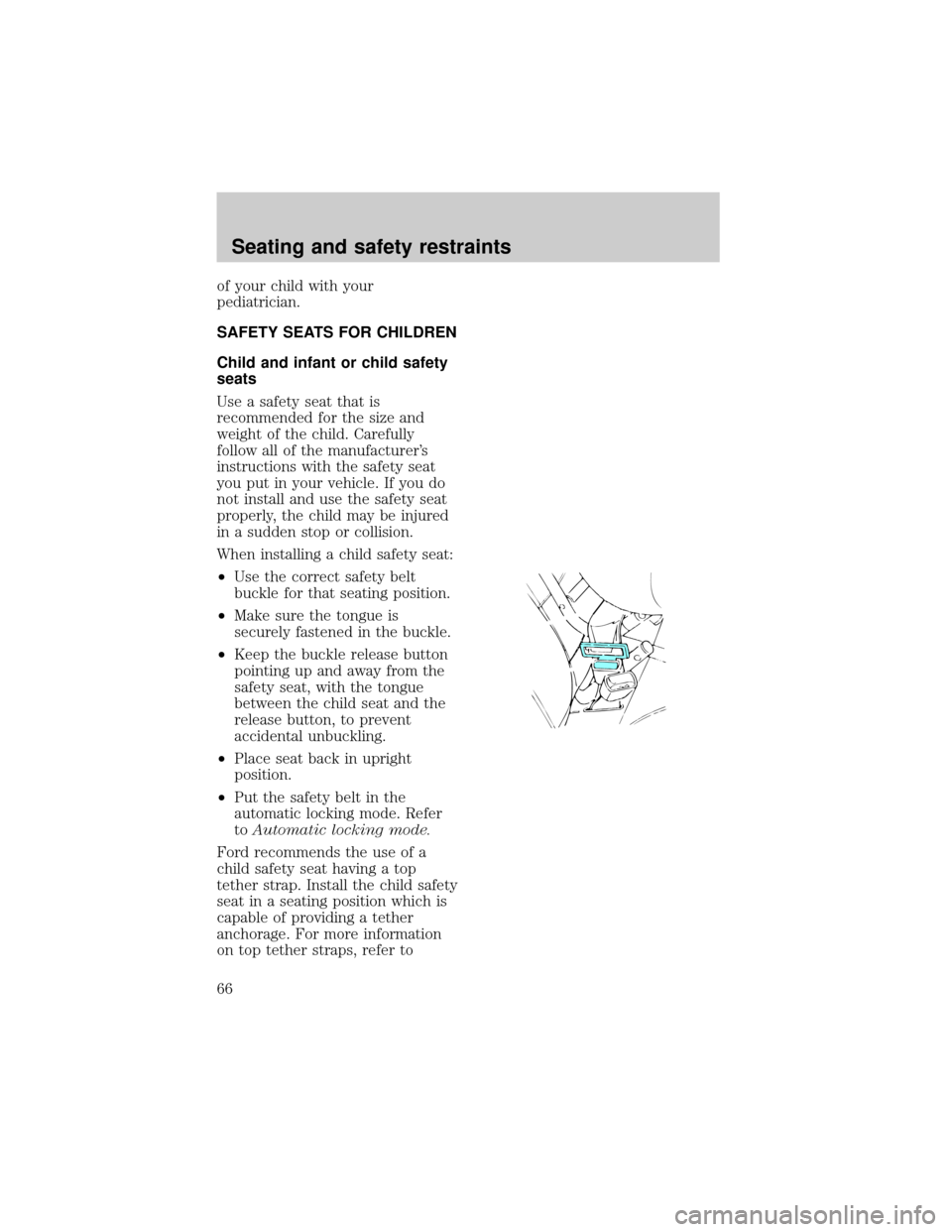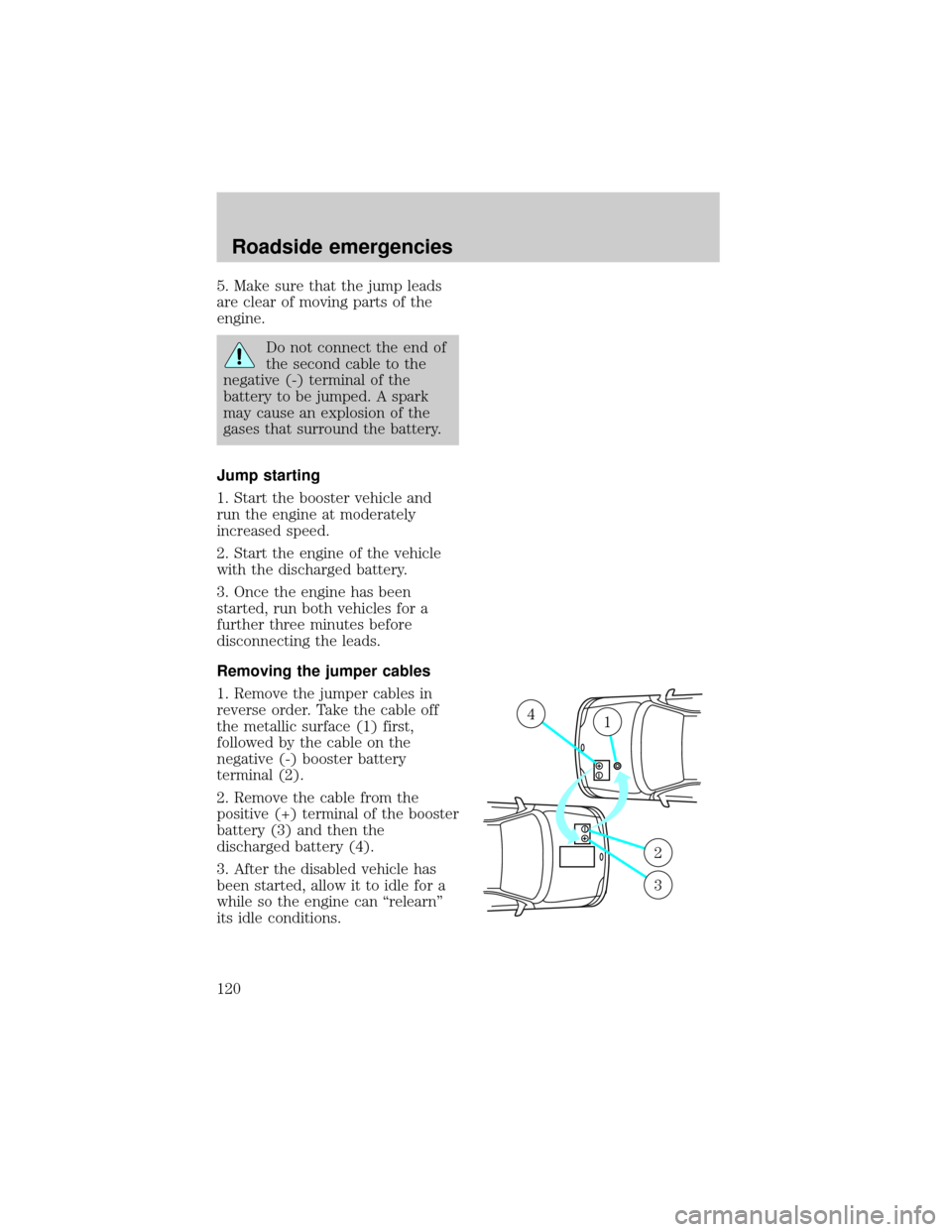Page 22 of 191

even after you have stopped the
vehicle.
Under normal conditions, your
vehicle's climate control system
should be left in any position other
than MAX A/C or OFF when the
vehicle is parked. This allows the
vehicle to ªbreatheº through the
outside air inlet duct.
²MAX A/C-Uses recirculated air
to cool the vehicle. MAX A/C is
noisier than A/C but more
economical and will cool the
inside of the vehicle faster.
Airflow will be from the
instrument panel registers. This
mode can also be used to
prevent undesirable odors from
entering the vehicle.
²A/C-Uses outside air to cool the
vehicle. It is quieter than MAX
A/C but not as economical.
Airflow will be from the
instrument panel registers.
²
(Vent)-Distributes outside
air through the instrument panel
registers. However, the air will
not be cooled below the outside
temperature because the air
conditioning does not operate in
this mode.
²OFF-Outside air is shut out and
the fan will not operate. For
short periods of time only, use
this mode to prevent
undesirable odors from entering
the vehicle.
²
(Panel and
floor)-Distributes outside air
Controls and features
22
Page 66 of 191

of your child with your
pediatrician.
SAFETY SEATS FOR CHILDREN
Child and infant or child safety
seats
Use a safety seat that is
recommended for the size and
weight of the child. Carefully
follow all of the manufacturer's
instructions with the safety seat
you put in your vehicle. If you do
not install and use the safety seat
properly, the child may be injured
in a sudden stop or collision.
When installing a child safety seat:
²Use the correct safety belt
buckle for that seating position.
²Make sure the tongue is
securely fastened in the buckle.
²Keep the buckle release button
pointing up and away from the
safety seat, with the tongue
between the child seat and the
release button, to prevent
accidental unbuckling.
²Place seat back in upright
position.
²Put the safety belt in the
automatic locking mode. Refer
toAutomatic locking mode.
Ford recommends the use of a
child safety seat having a top
tether strap. Install the child safety
seat in a seating position which is
capable of providing a tether
anchorage. For more information
on top tether straps, refer to
Seating and safety restraints
66
Page 120 of 191

5. Make sure that the jump leads
are clear of moving parts of the
engine.
Do not connect the end of
the second cable to the
negative (-) terminal of the
battery to be jumped. A spark
may cause an explosion of the
gases that surround the battery.
Jump starting
1. Start the booster vehicle and
run the engine at moderately
increased speed.
2. Start the engine of the vehicle
with the discharged battery.
3. Once the engine has been
started, run both vehicles for a
further three minutes before
disconnecting the leads.
Removing the jumper cables
1. Remove the jumper cables in
reverse order. Take the cable off
the metallic surface (1) first,
followed by the cable on the
negative (-) booster battery
terminal (2).
2. Remove the cable from the
positive (+) terminal of the booster
battery (3) and then the
discharged battery (4).
3. After the disabled vehicle has
been started, allow it to idle for a
while so the engine can ªrelearnº
its idle conditions.
+–
+–
41
2
3
Roadside emergencies
120
Page 159 of 191
affect on modern powertrain
components.
You may need to crank the engine
several times before the system
starts to pump fuel from the tank
to the engine. If you run out of
fuel, your Service Engine Soon
light may come on. For more
information on the Service Engine
Soon light, refer to the
Instrumentationchapter.
Calculating fuel economy
To accurately calculate your
vehicle's fuel economy:
1. Fill the tank completely and
record the initial odometer
reading.
2. Each time you fill the tank,
record the amount of fuel added
(in liters or gallons).
3. After at least three to five fuel
tank fill-ups, fill the fuel tank and
record the current mileage
reading.
4. Use one of the following
equations to calculate fuel
economy.
Liters used x 1004Total
kilometers traveled
Total miles traveled4Total
gallons used
Keep a record for at least one
month. This will provide an
accurate estimate of the vehicle's
fuel economy.
Maintenance and care
159
Page 189 of 191

High beams
indicator light ...........................10
Hood
release lever ............................128
Ignition
positions of the ignition ...........26
Instrument panel
lighting up panel and
interior .......................................17
Jump-starting your
vehicle .................................118,120
attaching cables ......................119
disconnecting cables ..............120
Keys
key in ignition chime ...............12
Lamps
dome lamps ........................36,171
fog lamps .................................167
headlamps ...............................165
high-mount brakelamp ...........167
interior lamps ....................36,171
map lamps ..........................36,172
tail lamps .................................169
License plate lamps ..................171
Lights, warning and indicator
air bag ..........................................9
anti-lock brakes (ABS) ............10
anti-theft ...................................10
brake ..........................................10
charging system ........................11
check coolant ............................11
liftgate ajar ................................11
low fuel ........................................7
oil pressure ...............................11
safety belt ...................................9
service engine soon .................7,8
turn signal indicator .................10
Lubricant specifications ...........181
Luggage rack .............................103
Mirrors
side view mirrors (power) .......17
Moon roof ....................................35Odometer .....................................15
Panic alarm feature, remote
entry system ................................42
Parking brake ..............................89
Parts (see Motorcraft parts) ....180
Power steering
fluid, checking and adding ....142
Rear window
wiper ..........................................35
Refill capacities for fluids ........180
Relays .................................106,113
Remote entry system .................39
illuminated entry ......................44
locking/unlocking doors ......40,41
replacement/additional
transmitters ...............................43
replacing the batteries .............42
Reporting safety defects ..........187
Safety restraints
automatic locking mode
(retractor) ............................53,54
extension assembly ..................56
for children ...............................63
for second row bench
seats ............................73,74,78,79
lap and shoulder belts .............52
maintenance ..............................57
proper use .................................51
warning light and chime .....11,57
Safety seats for children
attaching with tether straps ....70
automatic locking mode
(retractor) .................................67
tether anchorage
hardware ..............................70,71
Seats ............................................47
adjusting the seat, manual .......47
folding rear seats ......................50
head restraints ..........................47
Servicing your vehicle ..............123
precautions when servicing ...123
Index
189